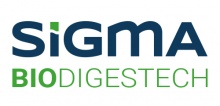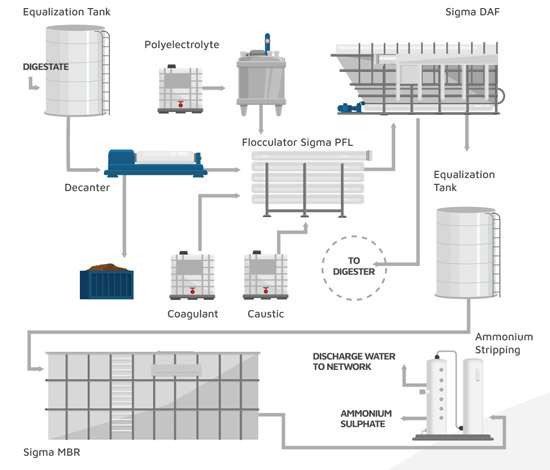
Clean water production
Clean water production
Digestate treatment to comply with the wastewater discharge regulations.
In addition, ammonium sulfate will also be obtained, which can be marketed.
The biodigestion of organic waste from various sources produces biogas, which has many potential and beneficial uses (biomethanization, production of electrical and heat energy, CO2 recovery, etc.). This process is totally sustainable for the environment as it reduces the use of fossil fuels.
However, these processes do not completely solve the problem of managing the waste because during a biodigestion process the waste is transformed, but not eliminated.
The digested product is called digestate, which can be treated to produce high quality fertilizers or to be discharged in compliance with the current regulations. This process is designed to ensure the production of high quality water using the BIODIGESTECH technology.

System main data

Up to 300 m3/d of digestate.
Footprint 20 x 20 mts.
Installed power 200 Kw.
Up to 150 m3/d of digestate.
Footprint 20 x 15 mts.
Installed power 125 Kw.
Up to 50 m3/d of digestate.
Footprint 15 x 15 mts.
Installed power 80 Kw.
Process description
The treatment system of the environmental solution consists in digestate purification, so that water is obtained with enough quality to be discharged into the sanitation network. Moreover, installing an ammonium stripping step, ammonium sulphate can be generated as valuable product. Prior to this process a pre-treatment is necessary to reduce the suspended solids.

PRE-TREATMENT
Centrifugal decanter
At this stage, the digestate will pass through a centrifugal decanter. The decanter will allow the separation of coarse solids and sludge.
The clarified water will be stored in a tank that will have sufficient capacity for the operation of the following stages of the treatment. From this tank, the water will be pumped with a centrifugal pump to the next stage of treatment, two pumps will be installed, one in operation and the other in reserve.
Flotation clarification
Digestate often contains high concentrations of fine solids and suspended solids, which can reduce the performance of filtration equipment.
In this stage, fine solids and suspended solids are separated applying a coagulationflocculation process. Then, the water containing flocculated solids is treated using a SIGMADAF flotation clarification equipment. After this treatment, the values of suspended matter in the digestate are minimal.
Biological treatment Sigma MBR
A biological treatment is then applied with a Membrane Bio Reactor MBR with special Sigma design consisting of: deoxygenation chamber, anoxic chamber and aerated chamber.
In this reactor biomass eliminates organic matter and nutrients.
In this special system, clarification is performed by Ultrafiltration membranes. This allows to obtain a clarified water completely free of suspended solids in addition to reaching high concentrations of biomass inside of the reactor, between 6000 and 12000 mg/L, thus optimizing the organic matter – biomass contact ratio and therefore the performance of the biological system. The amount of generated sludge in this type of reactors is minimal.
After the MBR, water has enough quality to meet the discharge limits of the sanitation network.
In some special cases when the substrates have a high nitrogen content (slurry, manure, slaughterhouse wastes, etc.), which is transformed into ammonium nitrogen during biodigestion, in the liquid phase the content of ammonium will be elevated and must be removed, for which a stripping stage is applied.
Ammonium stripping
The ammonium nitrogen contained in the water can be recovered as a solution of ammonium sulphate (NH4)2SO4 with a 40% richness.
The ammonium sulphate solution can be commercialized as nitrogen and sulphur rich fertilizer.
A system of stripper plus scrubber is applied for the ammonium recovery.
The water coming out from the MBR is collected in a tank where the pH is adjusted to 10. By means of two centrifugal pumps, one in operation and the other in reserve, the stripping column is be fed. In the stripping column, the water with ammonium is fed through the upper part while the air passes through the bottom part. Inside the column there is a filling media that increases the contact between water and air. Ammonium passes from the water into the air.
The air stream is redirected to the gas scrubbing column. Air rich in ammonium is introduced at the bottom while recirculating an absorbent solution of H2SO4, at controlled pH. Once the ammonium sulphate concentration of 40% is reached, the product is discharged.